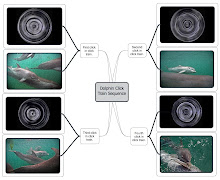Cancun & Riviera Maya, Mexico trip next month -- June 23-July 3, 2009.
While the swine flu hysteria, certainly delayed our trip planning, (the CDC and US State Dept. travel alerts were lifted two weeks ago and I just returned from Cancun this week -- happy and healthy) the scenario has created an exceptional opportunity for additional research time (and lots of in-water play time too) with the 50+ dolphins at three Dolphin Discovery (DD) locations --Isla Mujeres, Puerto Aventuras, Cozumel. Therefore, we are working quickly to seize this opportunity before all the tourists return.
We have very special access to dolphins at DD -- so this is a rare opportunity that we are opening to interns and others who want to be a part of exciting dolphin research, and to swim with dolphins in ways that are normally just not available.
Since the trip is still evolving as I write this, some details will be worked out over the next week as we receive responses from you. Meanwhile, here is our package:
__________________________________________________________________
INCLUDED:
10 days participation in dolphin research at 3 locations (Isla Mujeres, Puerto Aventuras, and Cozumel, Mexico). Gain unique field experience in obtaining scientific grade recordings of dolphins above and below water. Learn how to select the right recording equipment and software, and solve ground hum issues. Develop practical experience conducting ethograms during recording sessions.
1 Sealife Swim program (this structured swim includes dolphins, manatees, and sea lions-- by the way, Dolphin Discovery is the only facility that can offer hands on manatee interaction).
Multiple free-style (unstructured) swims with dolphins-- excellent for developing your relationship with them, game playing and filming. You will find these dolphins to be quite up-close and engaging underwater -- rare and special experiences indeed! Bring your underwater cameras! We will be working with several mothers and babies -- and probably will be able to arrange some in-water time with them too.
___________________________________________________________________
Price: $1,275.00
Please note:
In an effort to be as flexible as possible for each interns' budget -- we are NOT including housing/accomodations in this base price. We do however have all the connections to help you get discounted rates throughout our trip. Expect to spend between $80.00 - $180.00 per bedroom per night. There is a variety of housing options available and of course room sharing would help to cut this cost in half. We generally use two and three bedroom condos that keep
the costs per room in this range.
Also NOT included: Airfare, food, some ground transport and ferries. We personally plan $45 per person per day including tips. We fix our breakfast in the condo (saves time and money). However, you might find that you eat for a bit less. You would fly into Cancun, and fortunately, airfare is cheaper right now than in years. I flew from Miami to Cancun this past week for $250 including taxes -- and that was purchasing the ticket only 3 days before my trip.
Regarding ground transportation and ferries between DD locations, occasional taxis to dinner (quaint downtown Isla and exotic Playa del Carmen) -- you should budget about $120.00 total.
______________________________________________________________________
Briefly about us:
Jack Kassewitz -- With years of practical experience recording a variety of
cetaceans, Jack is a Committee Member of the Acoustical Society of America's
new Bioacoustic Working Group, which is currently defining the new International Standards for scientific grade recordings and software.
Donna Kassewitz -- As one of the original founders of Dolphin Discovery (DD), Donna has 18 years of experience in facilitating human/dolphin interaction and leading tours to the Mexican Yucatan. Donna's Ribbon Games and Peace on Earth Flag Ceremony with Dolphins are annual traditions with the dolphins at DD. You are invited to be a part of these events on this trip.
___________________________________




